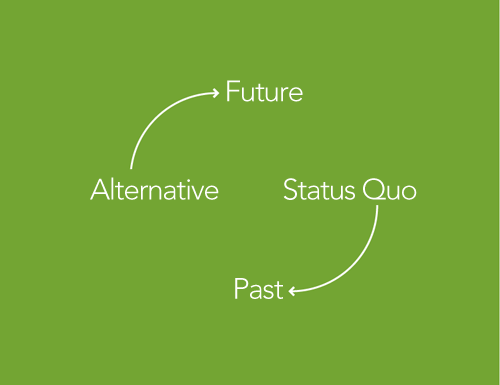
There has been remarkable green innovation in corporate America the past few years. New products, new services, entirely new business models.
Increasingly, these innovations have made good business cases. Wal-Mart's eco-efficiency continues to be an incredible boost both to the bottom line and the brand. Ecomagination passed its 5 year projected revenue plan a year ahead of schedule. Clorox's Greenworks is at eye level in the cleaner aisle, not stuck somewhere in the organics section.
And yet, there's a lingering trepidation in the C-Suite about doing more than dipping a toe in the sustainability pool. Clearly, sustainability has a perception problem.
Alternative Vs. Status Quo.
The current perception of green - despite all the progress that's been made - is that of an 'alternative'.
Alternative energy, alternative transport, alternative choice.
The problem with alternative is that it's not the status quo. In fact, the two terms are perceived as opposites.
Now let's consider the perception that comes with each of these terms.
Status quo may be seen as safe and a bit dull, but it's also tried and true, reassuring, and not risky. It comes with a steady paycheck.
Alternative, on the other hand, has newness, excitement and adventure going for it. Unfortunately, it also sounds a bit idealistic. Nice if you're in college, but not if you're standing in front of the CFO.
In short, status quo still trumps alternative when it comes to the perceived 'safe bet'.
This perception is tainting the debate on the green economy. For example, supporters of the status quo say the large scale shift to renewable energy will lead to a loss of thousands of jobs that will not re-materialize in solar, wind and other green energy businesses. There is disbelief that an 'alternative' could recreate the stability of the status quo.
Shifting The Paradigm
Before we can build change, we need to believe in change. And to believe in it, we need to have a positive impression of it.
The first step to that would be shifting the perception of 'alternative'.
Imagine if we chose to reposition 'alternative' as 'future'. How would that change what we think?
Future represents hope, opportunity, a way forward. Future is confidence and another chance.
So if 'alternative' were repositioned to represent future, what would that make 'status quo'?
As a counterpoint, it would by default be redefined as 'the past'.
And the past seems far less lucrative than the future.
This repositioning of terms, executed properly, could be a real step to breaking down our fear of green.
Status Quo? There Is No Such Thing
Ironically, every status quo was once the alternative. Just a few short years ago, the idea of reading op-eds online would've been labelled impossible. Ditto for innovations like digital music and mobile phones. Even electricity was considered radical thinking not so long ago.
In the green realm, most of us can remember life before recycling. It seems hard to imagine we were ever afraid of sorting plastics and paper from trash.
But even new wrinkles on recycling run up against citizen protest. Mayor Greg Moore of Port Coquitlam, BC, speaking at a Metro Vancouver event in 2009, described the hostile letter writing campaigns against curbside organic recycling in his city. He noted far more protest was created by the new recycling program than ever arose when the city considered homeless shelters in neighborhoods.
How to get around this ongoing protest against sustainability innovation? Perhaps the solution lies in revisiting the steps necessary for bringing new ideas to market effectively.
Need, Idea, Communication
At Maddock Douglas, we describe the innovation process in three steps.
First, you find a need. What do people want? Or if they can't verbalize the need, what seems to be missing in their day-to-day? This becomes the insight upon which innovation can be built.
Second, you create an idea to fulfill the insight. And bring that idea to fruition as a product, service or business model.
And finally, you communicate the idea in such a way that it binds the innovation to the original need.
I believe sustainability innovation has been doing a sub-par job in the communication department. We see wonderful new ideas, but don't feel the real need for them. Our status quo products, services and businesses seem to be just fine.
For that reason, the perception of green innovation is still that of 'alternative'. It definitely isn't seen as something we feel necessary.
Despite this, we are making progress. The green economy is growing, and green innovation is being successfully implemented into the mainstream. For that progress to hit the tipping point faster, we need more effective communication. We can't build it if we don't see the need for it.